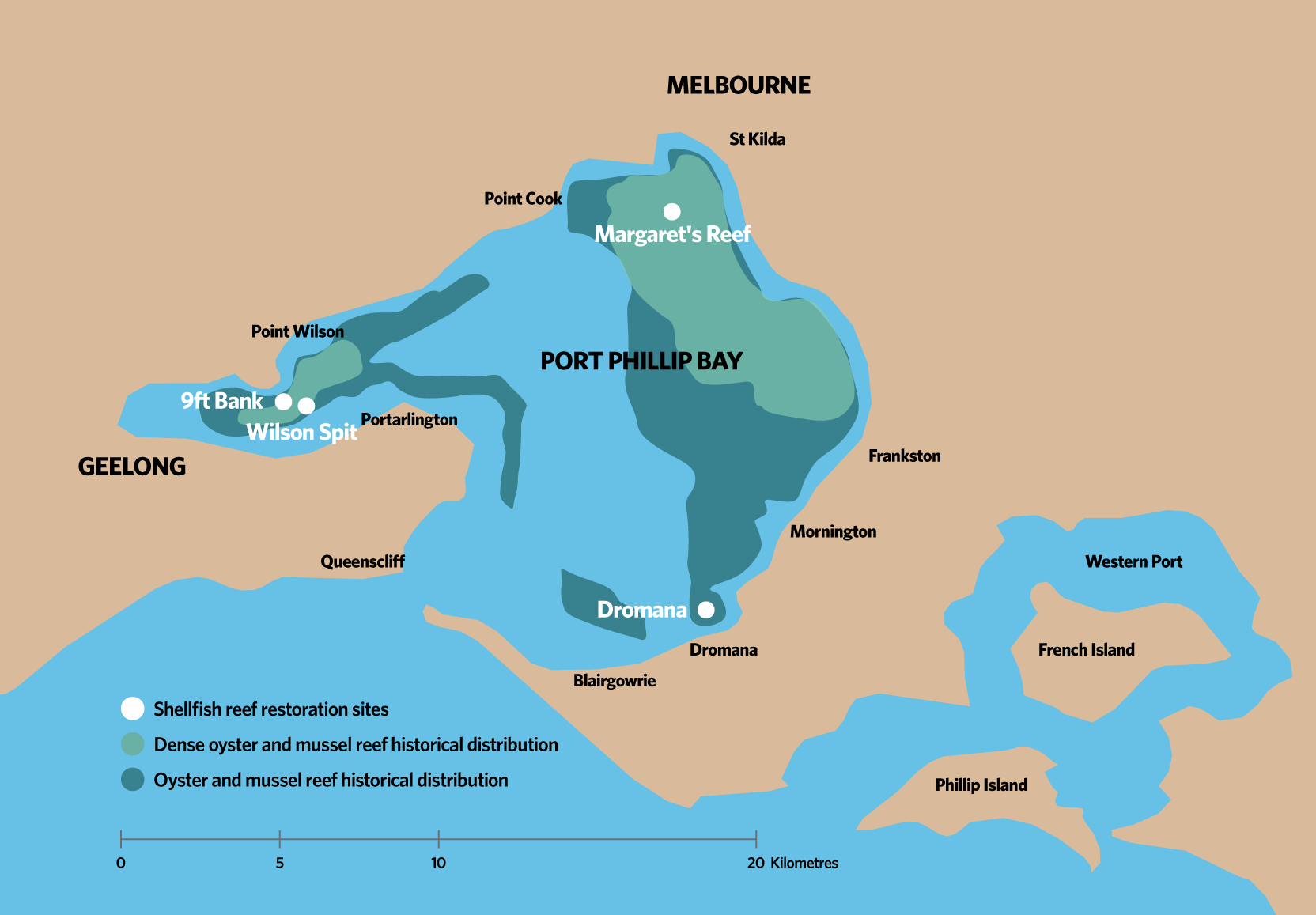
Reef Builder: Restoring Australia's lost shellfish reefs
Restoring the lost shellfish reefs in Port Phillip Bay
A Reef Builder project
Port Phillip Bay is the entrance to Australia’s busiest port and one of Victoria’s most popular recreational destinations.
The history of Port Phillip Bay’s lost reefs
Port Phillip Bay contains a wide range of marine habitats like leafy seagrass meadows, hard temperate coral outcrops, colourful sponge gardens and vast underwater sandy plains. A hundred years ago it was also home to extensive oyster and mussel reefs that supported a huge range of other sea life including fish, crabs, sea squirts, snails and sponges. Sadly, after many years of over exploitation, pollution, introduced species and disease, these shellfish reefs disappeared.
Rectifying the past and building the future
In 2015, in our first Australian shellfish reef restoration project, we joined forces with the Victorian Government, The Thomas Foundation and the Albert Park Yachting and Angling Club to rebuild Port Phillip Bay’s shellfish reefs.
TNC initially partnered with the Victorian Fisheries Authority and the University of Melbourne to undertake and experimental shellfish reef trial at two locations in Port Phillip Bay (Wilson Spit and Margaret’s Reef). This trial had a number of research questions with the primary focus being how to maximise the survival and growth of oysters and mussels.
The results of this trial then led to Australia’s first shellfish reefs being restored in Port Phillip Bay in April, 2017. Further builds occurred in November 2017, 2018 and 2020 at four locations in Port Phillip Bay, totalling nearly 7 hectares of reefs.
In 2021, The Nature Conservancy formed an exciting partnership with the Australian Federal Government, to bring shellfish reefs around Australia back from the brink of extinction. The existing restoration locations of Dromana, Margaret’s Reef and Wilson Spit were identified as key areas to expand on for the Reef Builder project, Australia’s largest marine restoration initiative.
Key stakeholders in the Port Phillip Bay restoration activity are: Kulin Nation Traditional Owners, Albert Park Yachting and Angling Club, Department of Energy, Environment and Climate Action (DEECA), Parks Victoria, Victorian Fisheries Authority (VFA), Deakin University, University of Melbourne, Victorian Shellfish Hatchery (VSH), Melbourne Water, OzFish Unlimited, Southern Ocean Environmental Link, VRFish, recreational fishers, divers, marine-care groups, hospitality sector.
Bringing shellfish reefs to Port Phillip Bay
As part of the Reef Builder initiative, five hectares of new shellfish reefs were restored across the three locations in Port Phillip Bay. Nearly 5 million Australian Flat Oysters and over 750,000 Blue Mussels were seeded to kickstart the recovery process.

Since 2017, there has been 49 individual reef patches restored, using over 3.600 locally sourced limstone rock, 510 tonnes of shells recycled through the Shuck Don't Chuck shell recycling project and seeded with (including during Reef Builder) 13.5 million Australian Flat Oysters and 2.7 million Blue Mussels.
Whilst there are notable differences between the restoration locations, the monitoring data to date indicates that each of the locations are moving towards the benchmark shellfish ecosystem and are supporting a range of fish and invertebrates.
Bringing the reefs to life
Post construction, the highest number of species recorded on the restored reef locations was at Wilson Spit (41 species at 13 to 18 months), followed by Dromana (38 species at 25 to 30 months) and Margaret’s Reef (37 species at 13 to 18 months).
At Dromana, large schools of juvenile fish were commonly observed including Snapper, Silver Trevally, Yellowtail Scad, Southern Goatfish and Bridled Leatherjacket, while large schools of Australian Herring were observed at Margaret’s Reef.
It doesn’t stop here
Whilst the monitoring frequency naturally changes as the restored reef bases become settled, the reefs are still. monitored for changes.
For more information on the achievements of the Reef Builder initiative, read the 2024 Reef Builder Final Summary Report.
Read more: